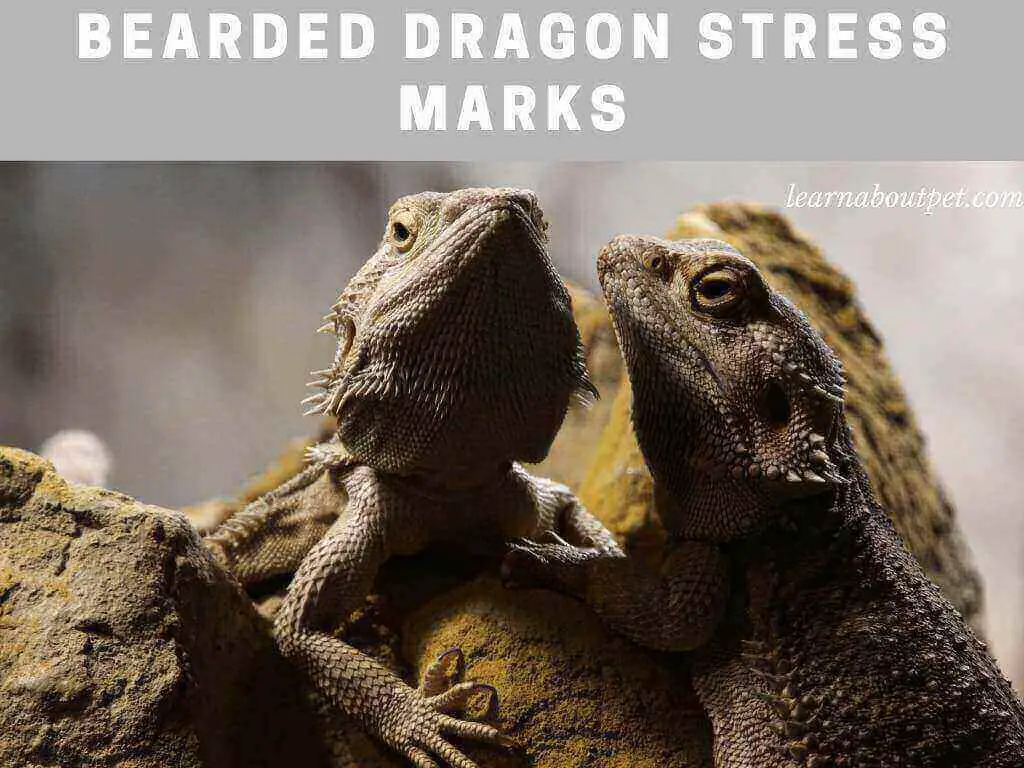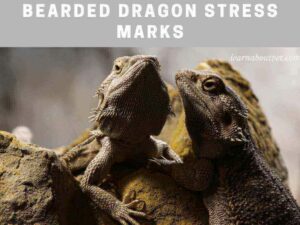As more knowledge, information, and convenience aids are made available in the market, people are adopting the bearded dragons more and more as pets. Besides one’s liking, it is a low maintenance pet, does not require much area and contraptions.
People have always wondered if bearded dragons show stress marks. Bearded dragon stress marks appear as dark lines or oval-shaped rings mostly on the belly of the beardie, the beard, and limbs. As the name suggests they are results of some stress or anxiety or fear.

Here we discuss the bearded dragon stress marks, their reasons, how to calm a stressed bearded dragon, and many other questions from enthusiasts like asking my bearded dragon is stressed what can I do and similar questions.
Read on. Hope you enjoy this blog and find it useful.
What Are Bearded Dragon Stress Marks?
Bearded dragons are cute little lizards from the reptile family Pogona. For some decades now people have been adopting them as pets in their homes.
Many beardie pet owners have observed marks on their pet’s body and wondered about the bearded dragon belly spots or bearded dragon spots on belly. Baby bearded dragon stress marks are also reported.
Experts advise that bearded dragon stress lines and darker colors appear on the beardie’s body when it is stressed or in fear. This is their natural way of responding and communicating with other fellows and species.
The appearance of bearded dragon stress marks on belly is prominent. Besides appearing on the neck area, they appear on the bearded spikes and limbs also. Can you get signs of stress marks from Bearded Dragon teeth?
What Do Bearded Dragon Stress Marks Look Like
When people hear of bearded dragon stress marks, they wonder how the stress markings on bearded dragon body look like.
The first signs of stress in bearded dragons is a color change. The beardie gets darker or black, easily seen on its beard area. Other shapes are dark lines or patterns looking something like oval shapes appearing on bearded dragon belly.
The stress marks mostly appear on the bearded dragon belly but can be seen on the beard area and the limbs also. This also holds true for the baby bearded dragon stress marks.
How Can I Tell If My Bearded Dragon Is Stressed?
Below we discuss some important points queried by many pet beardie lovers that how can you tell if your bearded dragon is stressed or how do I know if my bearded dragon is stressed?
The bearded dragon will tell its owner about its stressed situation by body signs. The first sign is the darkening of the skin in the neck area, especially the beard area.
The other prominent signs are the bearded dragon stress marks. Which mostly appear as bearded dragon belly spots or as dark color of the beard. Do you know if stress marks appear even during Bearded dragon Brumation process?
Besides the bearded dragon stress marks, there are other noticeable bearded dragon stress signs which are listed below.
- Puffed out beard. The beardie will inflate its beard area and also changes color to dark or black. This is also used as a sign of dominance.
- The body colors. Body colors change with age and during mating or shedding season or due to temperature change, but the stress signs will appear suddenly upon any incidence. The owner must have the experience to know that something is affecting the beardie to display that behavior.
- Running in terrarium. The beardie runs back and forth in their cage or tank. Or they stand on their hind legs against the glass wall of the tank, and with front paws try to climb up the glass wall. This is called glass surfing.
- Bearded dragon reflection stress is when the beardie sees its reflection in the glass and assumes it to be its rival and gets stressed.
- Food & drink. Not eating and drinking water. Although they can go without food for weeks, suddenly showing no interest in food asks for further investigation. As a result, bearded dragon stress weight loss will occur.
- Less activity. It has suddenly gone lethargic and is not very active or inquisitive.
- Less basking. The beardie pet is spending less time in the basking area and prefers to hide in its hiding area.
The above signs, other than the bearded dragon stress marks, help in how to tell if your bearded dragon is stressed inspections.
Why Is My Bearded Dragon So Stressed?
Many beardie owners, experienced vets, and naturalists have shared their findings for why is my bearded dragon stressed or why does my bearded dragon have stress marks?
There could be many reasons for the stress marks bearded dragon. Some important ones are discussed below.
Temperatures Of The Terrarium
The pet will feel uncomfortable with high or low temperatures. Must have a resting and basking area with temperature controls for each.
Sometimes it is observed bearded dragon stress marks in the morning. This is nothing to worry about. These bearded dragon stress spots appear in the morning after sleep.
This is due to the temperature difference from night to day. They disappear after some time.
Tank Size
A small enclosure will stress a beardie. It must have ample space to move and play around in a natural-like environment, must have a basking area, hiding place, twigs, etc. for it to play.
Hiding place
By nature, the beardie is a shy animal and prefers to stay in a safe place. It should be provided a hiding place in its tank, which it thinks is ‘a safe’ place to be in.
The beardie’s definition of the ‘hide’ will prevail over yours. It will not like it if it feels the hiding place is not safe enough and feels exposed to predators.
Humidity
High humidity also affects them and give stress, can also be an aid for spreading certain kind of skin infections.
Relocation Or Change In Environment And Surroundings
This phenomenon is also called the bearded dragon relocation stress. A beardie is very sensitive to changes in its surroundings or location. Many pet owners have reported of the bearded dragon stressed after moving.
For example, its tank has been moved to a new location, furniture or other large things in the room have been rearranged.
There is too much lighting, or the beardie can see some animal or big bird (which it perceives as a predator) outside the window.
Presence Of A New Member
Like another bearded dragon has been placed in the tank. This could get serious if a fight breaks out. Even if the beardie can view another animal or its own species from his tank, that is enough to trigger stress.
Loud Noises
Loud noises disturb the beardie. Like a barking dog, television, and radio, even yelling. The beardie will link it to a predator which could harm it. Although pet owners tell the beardie likes soft voice and music.
Clean Animal
The beardie likes to live in clean surroundings. Would like to have its tank cleaned regularly. Don’t leave any rotten food and excrements in the tank.
Food
The type of food, its quality, quantity, and improper timings can easily disturb the beardies. Keep varying the diet and include fruit treats. Do not overfeed. If the beardie does not finish the feed, remove it from the tank.
Handling
Pet owners report that bearded dragon darker than usual stress held more time. Too much and unnecessary handling by the owner or different people can also make the beardie stressed. Children surrounding & tapping the terrarium are a distraction for him.
Boredom
There are not many things of interest or activity in the beardie’s tank. The caretaker is not giving quality time. There are not many toys in its tank.
We discussed some possible causes explained by many pet owners and vets, which can easily give stress to your loving bearded dragon pet.
Your pet is solely dependent on you for its comfort, it can only tell you of his discomfort. You being the caregiver, need to investigate like a detective to know the actual reasons for the bearded dragon stress.
These are also referred to as stress marks in cage bearded dragon, as people observe their beardie in its tank or cage and assume it is due to its captivity, that it is stressed.
Do Bearded Dragon Stress Marks Go Away?
Vets and pet owners report that bearded dragon stress marks are not permanent. However, in some cases, they can stay for a long time.
This is mostly with baby beardies. Sometimes baby bearded dragon stress marks continue into the adult age, with apparently no reason and the beardie continues happily with the day-to-day routine.
Most of the time the bearded dragon stress marks disappear soon after the incident or cause is removed, or the beardie adopts to the new environment.
On average the bearded dragon stress marks will disappear in few hours to a week. Sometimes we hear people say my bearded dragon always has stress marks or bearded dragon stress marks won’t go away. This needs deeper investigation.
This could be the case of the juvenile or baby bearded dragon stress marks. Try to eliminate all the possible distractions for your beloved pet. Even very small changes can sometimes upset the small creature.
It could also be possible that the beardie in question has different temperaments from other fellows. It is more sensitive. Hence takes longer for the bearded dragon stress signs to disappear.
If the beardie is carrying on with daily routine jobs and shows all other signs of an active and healthy life, then there is nothing to worry about the stress marks bearded dragon.
Examination by a vet is recommended, to rule out any illness or disease.
How To Calm A Stressed Bearded Dragon
Once it is known that the beardie has bearded dragon stress marks, the pet owner naturally thinks what do I do if my bearded dragon is stressed? And asks how to get rid of bearded dragon stress marks.
As the bearded dragon stress marks are a natural reaction to its surroundings, they will go away once the distraction is removed or is over and the beardie does not perceive it as a threat.
First is to check and eliminate, if the beardie is not showing any signs of sickness or ailment. Check for normality in the following.
- Food intake. Is the beardie taking in its feed normally?
- Breathing. Normal is quietly and smoothly.
- Secretion. Unhealthy discharge from eyes, ears, nose, or mouth.
- Weight Loss. Rapid reduction in weight.
- Lethargy. Not doing normal activities.
- Bowel discharge. Its droppings and urine should look normal.
- Discoloration. The overall body color changes. This can happen during shedding, mating, or old age also.
- Strange Behavior. The beardie does not act normal and likes to recluse in its hide.
- Body shape. Belly bloating, overweight, injury to any part or limb.
If all the above signs are fine then the bearded dragon stress marks indicate other issues, which the caregiver has to investigate and take care of.
Besides contemplating on how to calm a stressed bearded dragon it is important to eliminate all other health or medical-related issues.

How To Destress Your Bearded Dragon
When one sees bearded dragon stress marks the owner first wonders why is my bearded dragon stressed out? And immediately thinks about how to help a stressed bearded dragon.
Some practical and proven actions on, how to destress a bearded dragon or how to calm a bearded dragon are discussed below.
- Cover the terrarium. Just by covering the tank, controlling lighting and temperature, the beardie can calm down.
- Bath. Some owners find that gently giving a bath has relieved their stressed bearded dragon.
- Less handling. Bearded dragons are placid lizards, the less they are handled, the better they feel.
- Develop bond. The beardie must recognize you, your voice, and your scent. It should not run away from you all time.
- Feed them yourself. You should always feed them yourself, so they recognize you all time. This also strengthens the bond between you two.
- Talk in a soft voice. Regularly talk to your pet in a soft and calm voice. He must remember your voice as reassuring. Do this while feeding, grooming, or when you are in the room. Not when he is sleeping.
- Shouting and high-pitched sounds (yelling) will be taken as a threatening predator approach and will instill fear and stress in the beardie.
- Stroking/Patting. Spend some quality time with your pet. People have found softly stroking on the head with hand soothes the beardie. Avoid this for a highly stressed beardie. It may not respond favorably to this.
Above mentioned actions are some examples of actual actions on how to get rid of bearded dragon stress marks. The owner has to be innovative to think of finding the reasons for the stress in the beardie and eliminate it.
Do Not’s In How To Calm A Stressed Bearded Dragon
Bearded dragon enthusiasts and vets have put up a ‘don’ts’ list for how to calm a stressed bearded dragon. A little error in handling a pet can upset it.
- Approach from behind. The bearded dragon can detect any object approaching from behind naturally and will take it as an approaching predator, putting it under stress. Always approach from the front even when bringing your hands to pick it up.
- Housing with other pets. Do not house with other pets, especially same species males and females. There would always be a fight for superiority and submissiveness.
- Small tank. Tank size is very important. It must be large enough for the reptile to carry on its daily activity of roaming and basking. It must have proper substrate and temperature controls.
- Interesting habitat. The beardie should not have a boring living. Place interesting objects in the tank to have its attention absorbed in different activities. Place rocks, twigs, hiding places, climbing branches, other toys to engage the reptile, try to enrich its life. Try to kill its boredom.
- Pick up properly. Beardies don’t like to be handled much. When picking them up, make sure you are handling them properly by placing your hands underneath them.
Their feet must rest on something. Dangling feet does not give comfort to the beardie. For these reasons, it is important to pay attention to details on how to get rid of bearded dragon stress marks.
How Long Does It Take For A Baby Bearded Dragon To Settle
Bearded dragons have not been studied so extensively as other animal species. However, with interest shown by pet enthusiasts and vets involved, a good source of data and information is now available.
Looking for how to detect baby bearded dragon stress marks and how do you calm a stressed baby bearded dragon? Baby beardies have the same traits as any bearded dragon, only being small, they get stressed easily.
After arrival in a new home, the beardie baby may adjust in a couple of days and start eating and playing normally. In extreme cases, it can be two to three weeks.
The first thing is the habitat or terrarium. It should be properly set up. Everything should be working, so when the guest arrives, it finds all things set and there is no distraction.
Give some time to the new guest to settle in. Communicate in a soft voice to develop a bond.
Some baby bearded dragons may carry the body stress marks into their adult age. This is considered normal, if the baby does not show other signs of illness, and continues with the daily activities with vigor.
Black Spots On Bearded Dragon
Bearded dragon pet owners have reported bearded dragon black spots or bearded dragon black spots on back, which look different from the bearded dragon stress marks.
Any spots other than the bearded dragon stress marks can be anything. There could be many reasons for black spots appearing. Some are highlighted here.
- Shedding. During skin shedding some marks may appear from losing scales, such marks vanish after some time.
- Injury/Bruise. Another can be some abrasion mark or some slight bruise from the beardie’s misdemeanor.
- Dirt. Simply some dirt dried and sticking to beardie’s skin.
- Burn mark. Sometimes the UV lamp can also give a burn mark, which blackens the skin.
- Fungus. This could be a serious issue. The fungus spreads on the body/skin. Consult vet.
- Parasite. If black spots move, surely it is a parasitic infection. Consult vet.
- Scale rot. This is due to bacterial infection of the beardie skin or scales. Consult a vet.
As a first remedy at home try to clean them with a bath. If it is dirt it will be cleaned. Other marks due to shedding, bruise, or burn mark will heal in few days and will not spread.
If they persist for many days and spread, then it is an infection or fungus. This needs a vet’s advice as it can get serious if not treated properly. In extreme cases, an amputation may be performed to save the limb.
Some other signs other than the bearded dragon stress marks which have been reported by bearded dragon owners are listed below.
A black spot on bearded dragon chin could be most likely fungus if it does not fall in any of the above descriptions. The best is to consult a vet in such situations when it is difficult for one to decide.
Bearded Dragon Black Spots On Neck
People reporting bearded dragon black spots on neck is dark coloration due to lower temperatures. The beardie is trying to warm up itself. During mating periods also the male beardie will show a darkened neck.
Bearded Dragon Black Tail Stress
Another form of bearded dragon black tail stress is a sudden stress sign by the darkening of its tail. Just have a look around and see what the object of stress was. The dark color of the tail also occurs during the shedding period.
Another cause of a dark tail is tail rot. This is a serious issue and not related to bearded dragon stress marks. The tail end cells die and necrotic tissues are formed.
Normally the affected part of the tail is amputated. This needs emergency treatment from a vet, as it can be fatal.
Black Spots On Bearded Dragon Tail
Besides the normal bearded dragon stress marks people also report black spots on bearded dragon tail. Such sporadic black marks on the beardie’s tail are not related to the stress marks.
These could be due to any other situation. Important thing is to keep it clean, and do the home remedies for few days and watch if it is spreading or anything else is happening.
At the slightest change, consult the vet. He will examine it and recommend action.
Why Does My Bearded Dragon Always Have Stress Marks?
Some pet owners report that their bearded dragon always stressed. Probably they refer to the ever-present bearded dragon belly spots.
In normal adult bearded dragons, the stress marks on bearded dragon belly or generally the stress marks on bearded dragons disappear soon after the removal of the distraction causing the bearded dragon stress marks.
Pet owners report that the stress marks on a bearded dragon disappear within few hours to a maximum of 2 weeks.
If bearded dragon stress marks won’t go away then there could be other reasons for prolonging it. The caregiver must investigate thoroughly the reasons for the extension and find ways on how to get rid of bearded dragon stress marks.
Each bearded dragon has its own personality. Some beardies might be more sensitive than others and easily disturbed by subtle changes, which other beardies may not be affected. Every pet owner would like to know how to calm a bearded dragon down quickly.
Researched by the vets, specialists, and enthusiasts there could be one of the following reasons for continued stress. If one distraction finishes another distraction may come in, and we get perpetual stress conditions.
Relocation to a new place, small or uncomfortable terrarium, too many distractions outside its tank, loud noises, the beardie can spot other animals or his species, a new person in the room, too much handling, poor food, lack of cleanliness, and boredom.
Sometimes baby bearded dragon stress marks are carried into adulthood, yet they don’t have any other serious health issues. If the beardie is carrying along with its daily activities as usual with vigor and energy, then nothing to worry about.
Talking about the bearded dragon stress marks, a question arises can stress kill a bearded dragon?
There may not be a direct answer, but due to continued stress, weakness sets in and the beardie spends most of its time in the hide. The immune system is compromised, which ultimately leads to illness and death.
For these very reasons it is essential to be knowledgeable about how to tell if a bearded dragon is stressed.
FAQ
How Do Bearded Dragon Stress Marks In Tank Look Like?
Pet owners report that their pets show bearded dragon darker than usual stress colors besides the bearded dragon stress marks when they put the pet in its tank. Outside with them, it is happy with no stress marks.
In this case, if all other signs are ok and the pet is with full energy, then nothing to worry about. However, the caregiver must keep on his investigations to find out why the bearded dragon has stress marks and how to get rid of bearded dragon stress marks.
Do Bearded Dragons Get Stressed When Shedding?
Skin shedding is a natural process and adults will shed a couple of times in a year. The color fades and the skin gets dry and peels off slowly. Bearded dragon stress marks shedding is painful and the beardie is stressed during this period.
They should not be handled much during this time, as it is painful for them. Their appetite decreases. When shedding is complete, the beardie return to normal. They do get bearded dragon stress marks during this period.
Is Blue Bearded Dragon Belly A Sign Of Stressed Dragon?
By mating bearded dragons with different genes, breeders are coming up with morphs having exclusive characteristics due to different genes inherited from their parents. Different colors and patterns are obtained. This is just a way to make more money.
The blue bearded dragon is so-called because of the somewhat transparency of the belly skin, due to which the belly has a bluish tint. This is more prominent in babies and fades as they grow up.
A true blue bearded dragon will have this color all over its body. Because of the rarity of such dragons, they fetch more price to the breeder.
Do Bearded Dragons Change Color When Stressed?
The color change is the bearded dragon’s first reaction to a stressful situation. Normally its body color darkens suddenly, especially in the bearded area.
The color change can be due to fear or stress when the beardie feels threatened or is upset even with the owner. Colors darken also as the beardie ages, but this is a slow process.
Why Do Bearded Dragon Have Stress Marks After Eating?
Some owners report the appearance of bearded dragon stress marks after eating its food. Vets tell this can be normal when the beardie’s digestive system starts working.
The marks should go away after some time after finishing its meal. It is not a sign of worry.
How To Differentiate Bearded Dragon Stress Marks VS Normal Skin?
This is another very debatable point as many pet owners report that their pets have sort of permanent bearded dragon stress marks. This is more common with baby beardies. Most vets consider it normal.
The baby bearded dragon stress marks fade over time and become less obvious in a couple of months. Some owners suggest even to not call them stress marks, because they are present even when the beardie is playing and apparently looks not stressed.
They appear dark when in the tank and lighten up when outside with the caregiver and enjoying the moments. This is a normal reaction.
One explanation given is that in the tank, it darkens the colors to absorb more heat, but when you take it out, it lightens in color as it is no more basking.
The color darkening and lighting are also dependent somewhat on the personality of the beardie. Some show more obvious changes and some show subtle changes in color.
However, it is good to keep observing and note sudden severe deviations. The very dark color is worth further investigation and consultation with a vet.
Final Verdict On Bearded Dragon Stress Marks
The bearded dragon stress marks are an important discussion point amongst pet owners. It is natural that everybody wants to know how to reduce bearded dragon stress or how do you get rid of stress lines on a bearded dragon?.
The stress marks bearded dragon is telling its loving owner, by the spots on bearded dragon belly that something is bothering it, and you better take care of it.

The bearded dragon stress marks are dark lines or shapes in oval and appear mostly on the bearded dragon belly, beard area, and limbs. The sudden change to a dark bearded dragon body color is also a sign of stress.
Pet owners have found if the distractions are taken care of, then the stress marks disappear soon, and the beardie returns to normal. It is important for the owner to know how to get rid of bearded dragon stress marks.
However, there might be cases when it has taken much longer for the stress lines on bearded dragon to disappear and owners complain bearded dragon stress marks won’t go away.
The stress marks bearded dragon mostly relate to change in the physical environment, discomfort, presence of other animals, poor food and hygiene, over handling, loud noise, and boredom.
In most prolonged cases the beardie continues with its daily routine activates normally. It does not affect it physically with illness etc.
When investigating for stress marks bearded dragon, consultation with a vet is advised to rule out any other signs of illness.

Welcome to Learn About Pet. My name is Rajkumar Ravichandran and I love all pets, travel, and amazing food. I write about my passion and personal experience caring for multiple pets in this blog! ❤️
Post Disclaimer
DISCLAIMER: THIS BLOG OR WEBSITE, "Learn About Pet", DOES NOT PROVIDE YOU WITH MEDICAL ADVICE AND IS NOT A SUBSTITUTE FOR MEDICAL ADVICE. ALWAYS GET IN TOUCH WITH YOUR PERSONAL VETERINARIAN AND USE INFORMATION HERE AS GENERAL ADVICE.
The information, including but not limited to, text, graphics, images and other material contained on this website are for informational purposes only. No material on this site is intended to be a substitute for professional veterinary advice, food recommendation, diagnosis, or treatment. Always seek the advice of your veterinarian or other qualified health care provider with any questions you may have regarding a medical condition or for pet food related questions.







